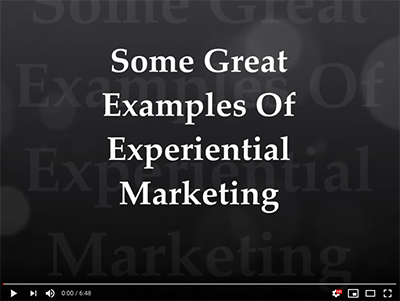Five Guiding Questions for Experiential Marketing

Experiential marketing, also known as engagement marketing, is a buzzword, increasing in popularity among strategists to describe a way to market a brand or product through experiences.

In college I majored in marketing but minored in psychology. Mainly because I felt it was important to understand human behavior overall, but also to understand what motivates consumer behaviors. My work experience with agencies taught me that people react very quickly (within a few seconds) to an experience.
The reality is that all marketing is experiential. It’s not just something marketers create for an onsite event. Marketing is always inventing ways for an audience to experience a brand or product in a memorable way. That’s the whole point of marketing. Opening a compelling direct mail piece can engage and is an experience. Visiting an interactive website can engage and is an experience. Receiving an email with embedded video or animation can engage and is an experience. Using an app that uses augmented reality so you can try on clothes using your smartphone in front of your mirror is a memorable experience. Are each of these examples experiential? Ah sure you betcha! The perception of how experiential, engaging or memorable they are is in the eye of the beholder, as the ability to evoke an emotional response isn’t a one-size-fits-all endeavor.
For those in your organization crafting campaigns, the question to be repeatedly asking yourself is how each aspect of the campaign is engaging the customer and creating an experience. Each aspect should be an experience in and of itself where the sum of all parts is the ultimate experience you want your customers to have with your brand.
Using image-based design and/or video has continually proven to be the strongest experiential component to any marketing campaign. Humans are visual. Humans have emotions. Very few humans have the time to read heavy text to understand your brand/offer message. Very few humans can get a full experience by reading text only. Don’t take it personally that your target audience doesn’t have the time to hang on your every written word. Even those who are engaging with your brand don’t have time to hang on your every word.
Marketers and creative professionals need to think outside the box and do something they’ve never done before to create an experiential campaign. They also must approach the idea of creating an experience with the following questions in mind:
- What is the purpose of your campaign?
- What is the goal of your campaign?
- What experience(s) do you want the customer to have? (This defines the journey to be mapped.)
- How does the campaign experience add value or benefit the customer?
- How do you measure the success(es) of your campaign?
 What do in-person or onsite memorable experiences have in common? They include experiences for as many senses possible: sight, smell, sound, touch and taste. Any one of these senses can evoke a memory or emotion by itself. The smell of freshly baked bread may remind you of your carefree childhood moments in grandma’s kitchen eating a piece of crusty baguette smothered with homemade strawberry jam. If you’re working on an experiential marketing campaign for New French Bakery at the Mid-America Food Expo, you would include similar experiences for all senses with the goal to reproduce those positive emotional responses and create a new positive memory with your brand.
What do in-person or onsite memorable experiences have in common? They include experiences for as many senses possible: sight, smell, sound, touch and taste. Any one of these senses can evoke a memory or emotion by itself. The smell of freshly baked bread may remind you of your carefree childhood moments in grandma’s kitchen eating a piece of crusty baguette smothered with homemade strawberry jam. If you’re working on an experiential marketing campaign for New French Bakery at the Mid-America Food Expo, you would include similar experiences for all senses with the goal to reproduce those positive emotional responses and create a new positive memory with your brand.
What do most virtual memorable experiences have in common? They include a video experience, virtual reality (VR), augmented reality (AR) or interactive smartphone app experience. For the most impactful and immersive video experiences, virtual reality (VR) glasses can be used. Video elements are by far the best way to impact the audience in a memorable way using images (sight), music and a well-written script (sound). Many times, the visual is enough for your brain to fill in the blanks for touch, smell and taste when you capture the right video footage or images.
Infinity can help you with that. Let’s talk.
